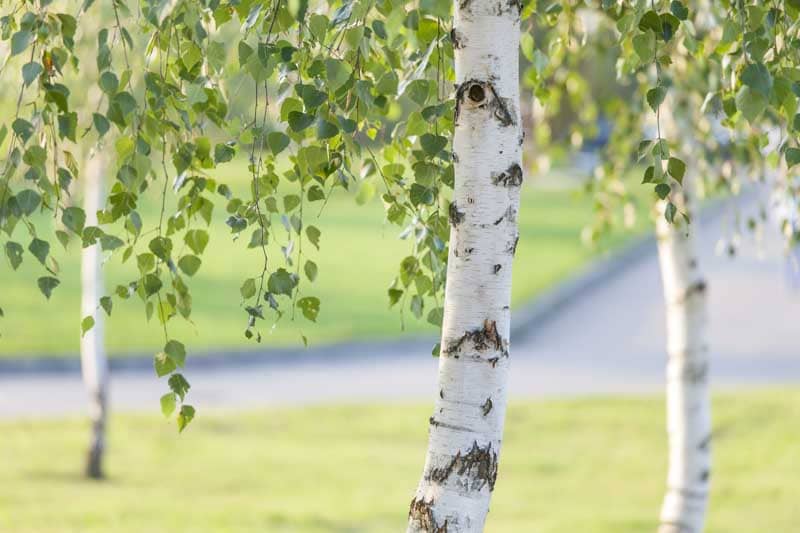When it comes to landscaping, choosing the right trees can make all the difference in creating a stunning and harmonious outdoor space. White bark trees stand out as a particularly attractive option for many reasons. Their unique appearance, ecological benefits, and versatility in various climates and soil types make them an excellent addition to any landscape. In this article, we will explore the myriad of reasons why white bark trees are perfect for your landscape, covering their aesthetic appeal, ecological advantages, and practical considerations.
Aesthetic Appeal of White Bark Trees
White bark trees are visually striking, adding a touch of elegance and uniqueness to any garden or landscape. The contrast of their bright bark against the green foliage and colorful flowers can create a breathtaking visual effect. Here are some of the top white bark trees known for their beauty:
Betula papyrifera (Paper Birch)
The Paper Birch is renowned for its distinctive white bark that peels away in thin, papery layers. This tree is not only beautiful but also adds a textural element to the landscape. In autumn, its leaves turn a brilliant yellow, providing a stunning contrast to the white bark.
Eucalyptus pauciflora (Snow Gum)
The Snow Gum features smooth, white bark with patches of grey and green, creating a marbled effect. This evergreen tree is native to Australia and is particularly valued for its ability to withstand cold climates while maintaining its striking appearance year-round.
Acer griseum (Paperbark Maple)
Though not entirely white, the Paperbark Maple has a light, cinnamon-colored bark that exfoliates in strips, revealing a creamy underlayer. This tree offers both visual and textural interest, making it a popular choice among landscapers.
Ecological Benefits of White Bark Trees
Beyond their beauty, white bark trees offer several ecological benefits that make them a wise choice for environmentally conscious landscaping. These benefits include improving air quality, providing habitat for wildlife, and supporting soil health.
Air Quality Improvement
Trees are natural air purifiers, and white bark trees are no exception. They absorb carbon dioxide and release oxygen, helping to mitigate the effects of climate change. Additionally, they filter pollutants from the air, improving overall air quality.
Wildlife Habitat
White bark trees provide essential habitats for various wildlife species. Birds, insects, and small mammals find shelter and food in these trees, promoting biodiversity in your garden. For example, the peeling bark of the Paper Birch offers nesting sites for birds and insects.
Soil Health and Erosion Control
The root systems of white bark trees help stabilize the soil, preventing erosion. Their leaves, when they fall and decompose, add organic matter to the soil, improving its fertility and structure. This creates a healthier environment for other plants in your landscape.
Versatility in Landscaping
White bark trees are incredibly versatile and can be used in a variety of landscape designs. Whether you have a small urban garden or a large rural property, there is a white bark tree that will fit your needs.
Urban Landscaping
In urban settings, white bark trees can be used to create focal points or to line streets and pathways. Their bright bark can lighten up shaded areas and add a touch of brightness to concrete-heavy environments. The Snow Gum, for instance, is a great choice for urban gardens due to its compact size and resilient nature.
Rural and Suburban Gardens
For larger properties, white bark trees like the Paper Birch can be planted in clusters to create natural screens or windbreaks. They can also be used to enhance the beauty of natural water features, such as ponds and streams, by planting them along the banks.
Seasonal Interest
White bark trees offer year-round interest, with their bark providing visual appeal even in winter when leaves have fallen. This makes them an excellent choice for creating a landscape that is attractive in all seasons.
Practical Considerations for Planting White Bark Trees
When incorporating white bark trees into your landscape, there are several practical considerations to keep in mind to ensure their health and longevity.
Site Selection
Choosing the right site is crucial for the success of your white bark trees. Most of these trees prefer well-drained soil and a location that receives full to partial sunlight. It’s important to consider the mature size of the tree and ensure there is enough space for it to grow.
Soil Preparation
Preparing the soil properly will give your white bark trees the best start. Amend the soil with organic matter to improve its fertility and drainage. Conduct a soil test to determine if any additional nutrients are needed.
Watering and Maintenance
Newly planted trees require regular watering until they are established. Mulching around the base of the tree can help retain moisture and suppress weeds. Pruning should be done to remove dead or diseased branches and to maintain the desired shape.
Pest and Disease Management
White bark trees are generally hardy, but they can be susceptible to certain pests and diseases. Regular inspection and early intervention are key to preventing serious problems. Using integrated pest management techniques can help keep your trees healthy.
Conclusion
Incorporating white bark trees into your landscape is a decision that brings both aesthetic and ecological benefits. Their striking appearance, ability to improve air quality, provide wildlife habitat, and enhance soil health make them an ideal choice for any garden. Whether you’re looking to add a focal point in an urban setting or create a natural screen in a rural landscape, there is a white bark tree that will meet your needs. By considering the practical aspects of planting and maintaining these trees, you can enjoy their beauty and benefits for years to come.


